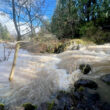The Willamette National Forest has announced that it will conduct prescribed fire operations this fall, pending the necessary approvals as the burn season has begun following the rain earlier this month.
The Oregon Department of Forestry announced Friday, Oct. 17, that all its districts have terminated fire restrictions, marking the end of the 2025 Oregon fire season declaration.
The Linn County Fire Defense Board, in coordination with the Oregon Department of Forestry – South Cascade District, declared the end of fire season effective Oct. 11.
“Through aggressive initial attack and the dedication of our firefighters, we had a season with significantly fewer acres burned compared to last year even with more fire starts,” said Kyle Williams, ODF deputy director of Fire Operations.
“This year had the potential to be similar to last year, but ODF firefighters showed up every single day to make sure that did not happen.”
Combined, lightning-and human-caused fire brought roughly 100 more fire starts on ODF-protected land compared to 2024 fire season. In response, the department’s protection districts and division took on the challenge.
“Due to the agency’s aggressive approach to initial attack to preserve natural resources, protect communities, and increase firefighter safety, many fire starts that happened this year were never heard about,” said Michael Curran, ODF Fire Protection Division Chief. “In 2025, 94 percent of fires on ODF-protected lands were put out at 10 acres or fewer.”
ODF Fire Season Statistics
Year to date, there have been 1,135 fires on ODF-protected lands resulting in 24,275 acres burned. ODF Complex Incident Management Teams (CIMT) have been mobilized six times to wildfires this year. The assignments were to the following incidents:
- Rowena Fire
- Elk Fire
- Marks Creek Fire
- Grizzley Complex
- Flat Fire
- Kelsey Peak Fire
Statewide to date, regardless of jurisdiction, there have been 2,569 fires that have burned 288,774 acres.
The start and end of fire season restrictions and regulations are set by each forest protection district based on the conditions in their area including drought, climatic forecasts, and seasonal trends. These restrictions and regulations are on activities prone to start wildfires, such as debris burning and certain equipment use, and are intended as preventative measures during times with elevated wildfire risks. The arrival of steady soaking rain, coupled with cooler temperatures and shorter days, usually triggers the closure of fire season.
The end of fire season removes ODF imposed fire restrictions on ODF-protected lands. However, many structural fire departments in Oregon still require a permit for debris burning, and slash burning requires a permit year-round, so check with your local fire department or ODF office before starting a burn.
As Oregon transitions to fall and winter, ODF districts across the state are shifting their attention to wildfire prevention, fuels reduction, mitigation and planning efforts.
USFS Burn Plans
The prescribed fires planned by the USFS in Linn County include:
- Administrative sites including the Cascadia Day Use Area and North Santiam Sportsman Club;
- Various units created from logging activities, Forest Service Roads 2234, 2031417, 2027, and 11;
- Various units created from wildfire suppression activities, Forest Service Roads 2212, 2041, 2047, 2041526, 2041528, 1133,1155, and 1152640; and
- Meadow restoration along Forest Service Road 2255822.
Underburning of surface fuels such as dead leaves, brush, and small trees, while leaving forest canopy and larger trees intact, is also planned in Linn County in the following areas:
- Various units from logging activities on Forest Service Roads 2027 and 2032417; and
- Camas Prairie meadow restoration on Forest Service Road 2027.
The prescribed fire activity may cause some areas to be closed to the public for several days, so residents are encouraged to watch for warning signs near prescribed fire areas and during burns.
Residents may experience smoke during the prescribed burns. Go to fire.airnow.gov/ to find more detailed information about air quality. When driving, slow down and turn on your headlights when you encounter smoke on the road.
Officials will evaluate weather conditions in the hours before a burn begins. If conditions warrant, scheduled prescribed fire activities may be canceled.
Information about the prescribed burns can be found at the Willamette National Forest Facebook page at www.facebook.com/willamettenf.
The USFS said it will notify county emergency management officials when burning begins.
Burn Season: Still Rules
With the start of Burn Season in Linn County, residents may resume backyard burning in accordance with local regulations. Conditions can change quickly, so the public is urged to check the Linn County Burn Line at (541) 451-1904 before burning to verify that burning is permitted on any given day.
For daily updates and regional information, visit the Willamette Valley Open Burning Announcement at smkmgt.com/burn.php.
Backyard debris burning is burning of wood, needle or leaf materials from trees, shrubs, or plants in an outdoor fireplace, burn barrel, or piles of yard debris that is not in support of an agricultural operation.
Campfires or recreational fires are not subject to these rules.
The Oregon Department of Forestry does not require written burn permits for backyard debris burning outside of fire season within its Forest Protection Boundaries.
Typically, burning is allowed in Linn County through Dec. 15 and in the spring from March 1 through June 15. These burn seasons are not guaranteed and may be postponed or shortened by the Linn County Fire Defense Board due to fire danger.
Follow the rules: DEQ open burning violations can result in penalties of up to $10,000 per day of violation. ODF can impose fines for burning violations and pursue costs for suppression if a burn escapes control.





